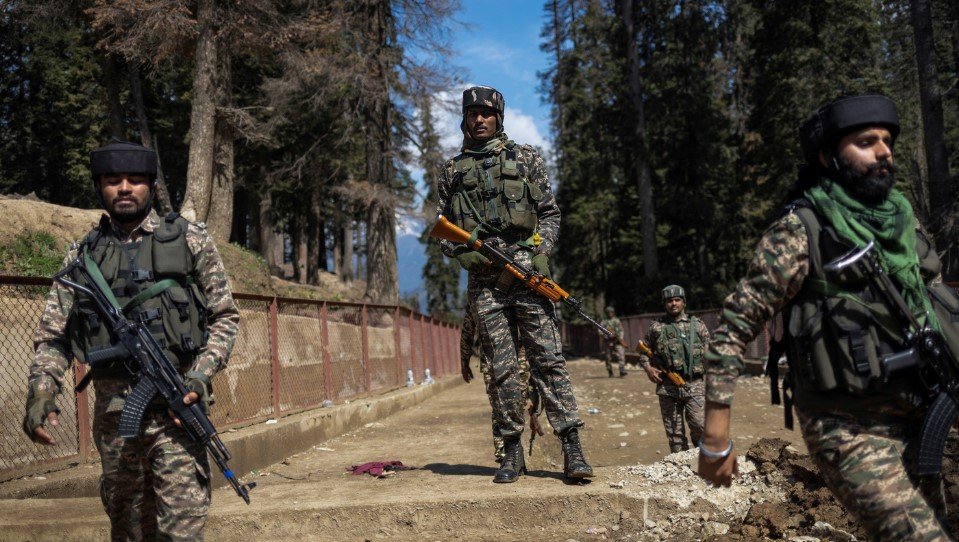The National Investigation Agency has concluded that the deadly April 22 attack in Pahalgam was carried out entirely by Pakistani nationals, debunking earlier reports that suggested local involvement.
Arrests in Pahalgam Flip the Narrative
What began as a murky manhunt in Kashmir’s Pahalgam has now taken a dramatic turn. After grilling more than 200 people—pony handlers, roadside vendors, and shuttered shopkeepers—the NIA made two arrests. And with that, everything changed.
According to senior officials, the arrested locals—Parvaiz Ahmad Jothar of Batkote and Bashir Ahmad Jothar of Hill Park—had provided food and shelter to the three terrorists. Their confession led the agency to an unexpected but resounding conclusion: none of the gunmen were from Kashmir.
They were Pakistani nationals, allegedly operating under Lashkar-e-Toiba’s command.

The Pakistani Link: Lashkar Once Again in the Spotlight
The NIA’s statement was crisp but weighty. The three attackers were “Pakistani nationals affiliated with the proscribed terrorist outfit Lashkar-e-Toiba.” The accused locals, now under custody, provided names, details, and events that matched intelligence intercepts.
Until now, security agencies had been chasing shadows. The April 22 attack had claimed lives and stirred up fresh anxiety in the Valley. Initial sketches released by Jammu & Kashmir Police pointed to two known Pakistanis—Hashim Musa and “Talha”—and one local man: Adil Hussain Thoker.
But turns out, that trio wasn’t even at the scene.
What Went Wrong with the Initial Sketches
In hindsight, officials admit the sketches were based on photos retrieved from a deceased militant’s phone. Junaid Ramzan Bhat, killed in a December 4 encounter, had earlier participated in an attack on Z-Morh tunnel workers. That assault left seven dead.
On his device? A group photo featuring Junaid and three other armed men. The image surfaced again after the Pahalgam ambush and, perhaps prematurely, became the basis for the April 24 suspect list.
It now seems that was a misstep.
One official said plainly, “We chased a ghost lead for a month.”
Where the Probe Turned—and Why It Took Time
The investigation was exhaustive. Not flashy, not immediate, but painfully detailed. Investigators trudged through the narrow lanes of Pahalgam, talking to locals, collecting digital trails, matching fingerprints and footprints.
At one point, suspicion fell on pony operators, who know the mountain paths better than Google Maps.
Eventually, it was a combination of tech forensics and human intelligence that led NIA agents to the Jothar homes. From there, the picture cleared up.
The Manhunt and the Militants’ Trail
According to NIA sources, the three terrorists were operating out of a forest camp just beyond the Pahalgam ridges. They’d been in the area for several days before the ambush.
One of them, now believed to be Suleiman Shah, has history. Intelligence officials connect him to the October 2024 massacre at Z-Morh tunnel. Seven engineers and workers were shot dead in that incident.
His associate, Junaid Ramzan Bhat, died in December. But it’s Shah who has reemerged as a key figure—allegedly involved in both plots.
Officials say Shah crossed over from Pakistan-occupied Kashmir in mid-2023 and remained off-grid until now.
Data That Changed the Game
One image—that viral photograph from Junaid’s phone—threw the Pahalgam probe off course for weeks. It looked convincing. It felt fresh. It spread like wildfire.
And that was the problem.
From police briefings to national headlines, that picture became the template for identifying suspects.
But when NIA showed different photos to the two arrested locals during interrogation, the story cracked. The attackers in the picture weren’t the ones who’d shared meals in Batkote and Hill Park before April 22.
That simple mismatch forced a rethink.
Summary of Key Details from the Investigation
Here’s a quick snapshot of the facts as they stand:
| Event/Element | Detail |
|---|---|
| Date of Pahalgam Attack | April 22, 2025 |
| Suspected Perpetrators (Now) | 3 Pakistani nationals linked to Lashkar-e-Toiba |
| Earlier Suspects (Sketches) | 2 Pakistanis + 1 local (Adil Hussain Thoker) |
| Arrested Locals | Parvaiz Ahmad Jothar, Bashir Ahmad Jothar |
| Role of Arrested Locals | Provided food and shelter to attackers |
| Attacker Likely Involved Before | Suleiman Shah (linked to Z-Morh tunnel attack, Oct 2024) |
| Photo that Confused Probe | Recovered from deceased Junaid Ramzan Bhat’s phone |
| Agencies Involved | NIA, J&K Police, central intelligence units |
One officer summed it up bluntly: “Photos misled us, but the confession sealed it.”
Still No End to Cross-Border Tensions
As political tempers rise and diplomacy falters, this case again underlines a chronic problem—Pakistan-based infiltration and the logistical maze behind it.
Security experts now warn that the attack could be a sign of a fresh infiltration doctrine. Smaller squads. Deeper hideouts. Local enablers who may not even realize the full scope of who they’re dealing with.
In the coming weeks, more arrests could follow. But for now, the NIA’s latest finding delivers two things—clarity and concern.
Because if all three attackers were indeed Pakistani, then it’s no longer just a local threat.
